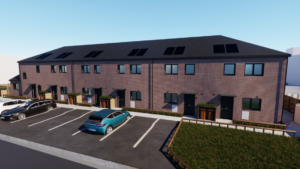Yet the planning system is the key mechanism by which the fabric and feel of our built and natural environments are created – and so has a huge bearing on our day-to-day lives and wellbeing.
And while people may not be familiar with the mechanisms of the planning system, they very much care about its outcomes. From the number and affordability of houses that are built at the end of the road, to the schools or bus services for new developments, to the protection of green spaces – whether you live in a village, a town or a city.
But the way planning works at the moment is failing to deliver. Local communities – those people who are affected most by, and live with the outcomes of planning decisions – are all too often unable to actually influence the decision making process. There is a power imbalance in place that favours large developers whose primary goal (as private businesses) is to maximise profit, and not to meet genuine community need.
This imbalance of power exists because the government has fundamentally misunderstood the nature of the housing crisis, and in turn weakened planning rules to favour those big developers.
The true crisis in the housing market is one of affordability, and therefore solving it is not just about increasing the overall supply of housing, as in line with current government thinking. More important is the types of homes we build, where we build them and who they are built for.
Young people are finding it harder than ever to get on to the housing ladder, with only 37% of 25-34 year olds owning a home, compared to 59% just over a decade ago. And people living in rural areas often face higher average house prices than urban areas, while earning lower incomes. Developments must be planned according to genuine needs like these that vary up and down the country.
But, private developers generally are not interested in taking these kinds of projects on because they are less profitable. So, loosening planning rules will go no way towards solving the affordable housing crisis. We need stronger planning rules to empower local communities to guide the process, in negotiating with councils and developers, in line with their specific needs.
And it’s clear that people want more from the planning system – perhaps without realising. Polling conducted by the Campaign for the Protection of Rural England (CPRE) last year showed that only 5% of people think that the national government is doing a good job of identifying housing needs in their local area. People are frustrated that the housing crisis continues unabated and they expect more from our government.
But it is entirely possible to have a planning system that is rebalanced towards community and environmental interest – this is true sustainable development, something the current planning framework purports to support. It is a matter of choice for government on where it puts its emphasis – on meeting people’s genuine needs and safeguarding our countryside for future generations, or fuelling market demand and lining the pockets of private interests through the inflated housing market.
The fundamental problems are not being addressed
We are taking the government’s proposed changes to planning policy seriously. It is our absolute priority for the coming months.
You can read out initial reaction to the government’s proposals here.
We are happy to see how our influence has shaped certain parts of the proposals, including continued protection of the green belt, stronger promotion of using brownfield land, and emphasis on developer accountability, including steps toward closing the viability loophole that has resulted in the loss of many affordable homes.
However, the fundamental problem with the NPPF has not been addressed. It continues to insist that development ‘needs’ should be met, but conflates actual people’s ‘need’ for development with abstract indicators of ‘demand’ based on ‘market signals’.
This leads to the setting of unrealistic national housing targets (currently 300,000 houses per year) that developers have neither the will nor the desire to meet. When targets are not met, it is the local authorities that feel the brunt of it. Their influence over where developments go, what they are, and who they are for, is taken away, and developers are given even more power to cherry pick the cheapest sites to build on (usually swathes of green land), and the types of houses to build (ones that make the most profit and are not in line with local need).
Until this underlying issue is resolved, the NPPF will not deliver truly sustainable development.
- Join the Planning for People campaign here.
















